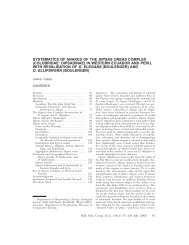cryptic species within the dendrophidion vinitor complex in middle ...
cryptic species within the dendrophidion vinitor complex in middle ...
cryptic species within the dendrophidion vinitor complex in middle ...
Create successful ePaper yourself
Turn your PDF publications into a flip-book with our unique Google optimized e-Paper software.
SPECIES IN THE DENDROPHIDION VINITOR COMPLEX N Cadle 205<br />
<strong>in</strong> ano<strong>the</strong>r 18% <strong>the</strong> bands were up to 2.5<br />
rows wide; <strong>in</strong> one specimen, <strong>the</strong> neck bands<br />
were three rows wide and <strong>in</strong> ano<strong>the</strong>r <strong>the</strong>y<br />
were less than one row wide. In some<br />
preserved specimens (e.g., Fig. 10C) <strong>the</strong><br />
pale dorsal bands are <strong>in</strong>dist<strong>in</strong>ct posteriorly,<br />
seem<strong>in</strong>gly because of secondary lighten<strong>in</strong>g<br />
of <strong>the</strong> <strong>in</strong>terspaces between <strong>the</strong> pale bands.<br />
Crossbands extend down to lateral edges<br />
of ventrals and merge with dark pigment on<br />
<strong>the</strong> lateral edges of <strong>the</strong> ventral scales.<br />
Posterior crossbands become <strong>in</strong>vested with<br />
dark pigment so that each crossband is<br />
broken <strong>in</strong>to a transverse series of vertebral<br />
and lateral pale spots (ocelli) separated by<br />
dark pigment (lateral ocelli on dorsal rows<br />
3–5 and compris<strong>in</strong>g adjacent parts of three<br />
or four scales). Narrow broken blackish<br />
lateral stripe on suture l<strong>in</strong>e between dorsal<br />
rows 2–3 on posterior third or more of body;<br />
dist<strong>in</strong>ctness and extent of <strong>in</strong>terruption of<br />
this stripe varies. Ventrolateral blackish tail<br />
stripe on suture between subcaudals and<br />
dorsocaudal row 1. The dark posterolateral<br />
and tail stripes are <strong>in</strong>dist<strong>in</strong>ct <strong>in</strong> some<br />
specimens.<br />
Top of head uniform brown or gray down<br />
to upper edges of supralabials. Ill-def<strong>in</strong>ed<br />
postocular stripe extend<strong>in</strong>g across top edge<br />
of penultimate supralabial. Rest of supralabials<br />
and gular region immaculate whitish.<br />
Venter immaculate except for fairly pale<br />
brown/gray speckl<strong>in</strong>g (often conta<strong>in</strong><strong>in</strong>g<br />
some larger dark spots) on extreme lateral<br />
edges. Subcaudals immaculate; no <strong>in</strong>vest<strong>in</strong>g<br />
dark pigment or spots on subcaudals or<br />
posterior ventrals (compare D. crybelum).<br />
One specimen from Costa Rica (KU 35638)<br />
has an unusual ventral pattern: <strong>in</strong> addition<br />
to lateral dark blotches, <strong>the</strong> anterior third of<br />
<strong>the</strong> body has short dark lateral l<strong>in</strong>es across<br />
<strong>the</strong> anterior edges of <strong>the</strong> ventral plates.<br />
These l<strong>in</strong>es are never complete (as <strong>in</strong> some<br />
o<strong>the</strong>r Dendrophidion, e.g., D. paucicar<strong>in</strong>atum),<br />
<strong>the</strong> extensions occupy<strong>in</strong>g only <strong>the</strong><br />
lateral portions of <strong>the</strong> plates.<br />
Juveniles are similar to adults but color<br />
tones are lighter. Anterior ground color<br />
medium to pale brown (unlike juvenile D.<br />
crybelum). Ocelli on <strong>the</strong> posterior body are<br />
poorly def<strong>in</strong>ed because <strong>the</strong> <strong>in</strong>vestment of<br />
pale bands with dark pigment is much less<br />
<strong>in</strong> small juveniles than <strong>in</strong> adults.<br />
Distribution (Fig. 11). Atlantic versant of<br />
Central America from extreme eastern<br />
Honduras to eastern Panama at <strong>the</strong> Colombia<br />
border; upland Pacific dra<strong>in</strong>ages <strong>in</strong><br />
northwestern Costa Rica (Cordillera de<br />
Tilarán and Cordillera de Guanacaste) and<br />
<strong>in</strong> Panama. The elevational range derived<br />
from data associated with specimens is 10 to<br />
1,433 m (most records ,200 m). Records<br />
from <strong>the</strong> Pacific lowlands of Costa Rica<br />
(Savage, 2002: 656; Laurencio and Malone,<br />
2009) are erroneous, as discussed below.<br />
The distributions of D. <strong>v<strong>in</strong>itor</strong> and D.<br />
apharocybe are separated by about 400 km<br />
at <strong>the</strong>ir closest localities <strong>in</strong> Guatemala/<br />
Belize and Honduras, respectively (Fig. 11).<br />
Savage (2002: 656, map 11.79) <strong>in</strong>dicated<br />
two lowland localities of ‘‘Dendrophidion<br />
<strong>v<strong>in</strong>itor</strong>’’ on <strong>the</strong> Pacific side of Costa Rica<br />
(denoted by ‘‘3’’ <strong>in</strong> Fig. 17). I conclude that<br />
both are based on mistaken identities (I am<br />
<strong>in</strong>debted to Jay M. Savage for po<strong>in</strong>t<strong>in</strong>g me<br />
toward <strong>the</strong> source of <strong>the</strong> records and to<br />
Gerardo Cháves for <strong>in</strong>formation and photographs<br />
of UCR specimens). The first, due<br />
east of <strong>the</strong> tip of <strong>the</strong> Nicoya Pen<strong>in</strong>sula<br />
(Savage, 2002: 656, map 11.79), is based on<br />
UCR 14406 and 14620, which were obta<strong>in</strong>ed<br />
dur<strong>in</strong>g a survey of Carara National<br />
Park (Laurencio and Malone, 2009; David<br />
Laurencio, personal communication, March<br />
2011). These specimens were <strong>in</strong>itially identified<br />
as ‘‘D. <strong>v<strong>in</strong>itor</strong>,’’ but both have divided<br />
anal plates and pattern characters of D.<br />
percar<strong>in</strong>atum ra<strong>the</strong>r than ‘‘D. <strong>v<strong>in</strong>itor</strong>’’<br />
(characters confirmed from photos provided<br />
by Gerardo Cháves, who also exam<strong>in</strong>ed <strong>the</strong><br />
specimens at my request, May 2011). The<br />
second erroneous record is from <strong>the</strong> Pacific<br />
lowlands due north of <strong>the</strong> Osa Pen<strong>in</strong>sula<br />
(Savage, 2002: 656, map 11.79), purportedly<br />
based on UCR 7235 cited by Lieb (1988)<br />
from Cajón (north bank of <strong>the</strong> Río Térraba,<br />
about 80 m, Puntarenas Prov<strong>in</strong>ce). However,<br />
that UCR number is seem<strong>in</strong>gly <strong>in</strong> error,<br />
and <strong>the</strong> UCR collection currently has no<br />
specimens of ‘‘D. <strong>v<strong>in</strong>itor</strong>’’ from Puntarenas<br />
Bullet<strong>in</strong> of <strong>the</strong> Museum of Comparative Zoology harv-160-04-01.3d 11/4/12 19:59:12 205







